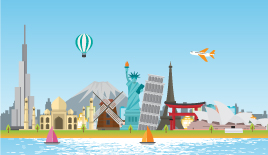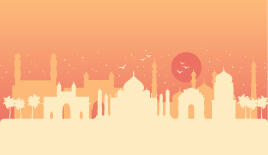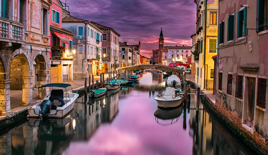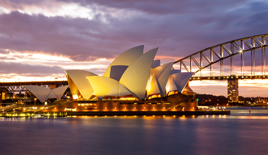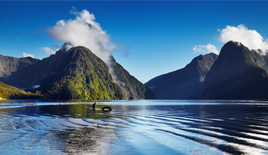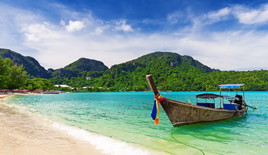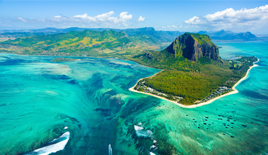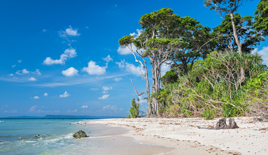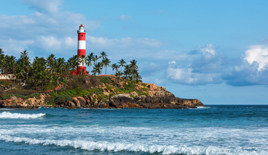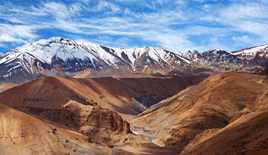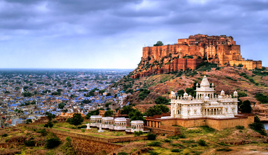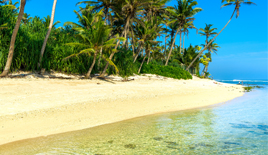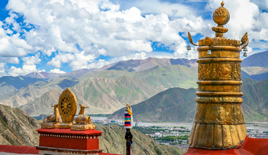About Bhutan Holiday: A vacation to Bhutan is said to be one of the most profound holiday experiences. Thomas Cook India’s Bhutan holiday packages are your perfect travel companions in this heartfelt experience. Your Bhutan holidays will be a series of evocative experiences set against the stunning backdrop of the majestic Himalayas. Thomas Cook India’s Bhutan holiday packages range from a quick 4 nights and 5 days to more relaxed 9 nights and 10 days. Prices start from a very reasonable INR 33,900 and go up to an indulgent INR 1,99,000. Whichever holiday package you choose, Thomas Cook India ensures that your Bhutan trip offers you the best value for your money. You can not only book your Bhutan tour on our website, but you can also customise it! Leave the finer details of planning to us and get ready for an adventure.
Because adventure is what you get when your Bhutan tour has been designed by a team of experts who are true-blue ardent travellers. With Thomas Cook India, your Bhutan holiday is sure to be a trip worth remembering for a long time to come.
Embark on a serene winter escape to Bhutan with special discounts of up to ₹10,000 on your trip!
Your Bhutan holiday will start at one of the major cities which enjoys great connectivity with the Himalayan mountain kingdom such as Kolkata, Bagdogra, Guwahati, Delhi and Mumbai. But regardless of where you book one of Thomas Cook India’s Bhutan holiday packages, you will surely enjoy a hassle-free holiday.
Most Popular Bhutan Tour Packages
| Tour Packages Name | Duration | Price |
|---|
| Albelu Bhutan – Ex Ahmedabad | 6 Nights 7 Days | Rs. 92 000 |
| Bhutan – Ex Bangalore | 7 Nights 8 Days | Rs. 96 000 |
| Albelu Bhutan Extravaganza - Ex Ahmedabad | 6 Nights 7 Days | Rs. 116 000 |
| Bhutan Extravaganza - Ex Bangalore | 7 Nights 8 Days | Rs. 122 000 |
| Albelu Bhutan Premium - Ex Ahmedabad | 6 Nights 7 Days | Rs. 186 000 |
About Bhutan
Nestled amidst the magnificent Himalayas, the land of the Thunder Dragon inspires awe and wonder with its treasure chest of pristine natural beauty. The emerald mountains scattered with the varied hues of multicoloured monasteries and houses, seem like a beautiful picture postcard. Whether you travel solo or with family, Bhutan will be witch you with its dazzling beauty and simple charm, a potent combination. Sitting pretty between Indian and China, the last great kingdom of the Himalayas draws you in with its craggy charm and alpine climate. Be a part of the annual Tshechu and join the locals in praying to the Guru Rinpoche, revered here as the second Buddha. Share their meals and dance their dances, and you will find yourself being carried away on waves of celebrations full of passion and fervour.
If you want a break from Bhutan’s mesmerising calm, Bhutan has a whole lot of trekking trails that will take you on adventures of Himalayan proportions. Even visiting a monastery can be an adventure. Case in point, the Tiger’s Nest Monastery is perched 1,200 metres above the Paro Valley. Apart from being a preferred choice for a rejuvenating retreat, Bhutan is also popular for a memorable honeymoon. The leisurely pace of life here is beautifully interspersed with bursts of adventure that add spice to your holidays. From the crisp mountain air redolent with the aromas of nature to the craggy texture of the terrain, Bhutan is a treat for all your senses. Book a Thomas Cook Bhutan holiday package today to experience it all yourself.
The Best Time to Visit Bhutan
Spring (March to May) and autumn (September to November) are the best seasons to visit the Himalayan kingdom of Bhutan. In spring, the temperatures range between 3°C to 25°C, while in autumn they hover between 10°C to 23°C. Even with the wild variations in temperatures, these two are the best seasons to be in Bhutan, because it doesn’t rain. Bhutan receives most of its rainfall during summer and it snows during winter. The mild weather of the shoulder seasons is perfect and the best time to visit Bhutan for sightseeing and exploring the wild beauty of Bhutan.
Not only can you get your sightseeing done without any interruptions, but you also find all the main tourist attractions open during these two seasons. Some parts of the country may become inaccessible due to heavy rains and snowfall during summer and winter respectively. Summer is still a good time to visit Bhutan if you can brave the rains and settle for a curtailed itinerary. But the subzero winter temperatures and the snow will keep most of the travellers away during the season.
In spring you can join the locals in celebrating the Paro Festival, Gomkora Festival and the Ura Yakchoe. Autumn has a bigger spread of celebrations with festivals such as Thimphu Tshechu, Wangdue Tshechu, Tamzing Phala Choetpa, Jambay Lhakhang Tshechu, Jomolhari Mountain Festival and the Black Necked Crane Festival.
How to Reach Bhutan
You can reach Bhutan by air and road from India. There is no direct rail connectivity. The fastest way to reach Bhutan is by air. Though Bhutan has many domestic airports, Paro International Airport is the sole gateway into Bhutan by air from outside. Druk Air, Bhutan’s national airline, operates regular flights from Kolkata, Bagdogra, Guwahati, Gaya, Delhi and Mumbai. Among these only Kolkata enjoys direct connectivity to Paro. The rest all offer connecting flights. Kolkata also has the most frequent of flights.
A road trip into Bhutan is the most popular way to get into the country. You have a choice of 3 points of entry into Bhutan from India:
- Jaigaon - Phuentsholing Border
- Gelephu
- Samdrup Jongkhar
Out of these, The Jaigaon - Phuentsholing border is by far the most popular option. It is the most easily accessible border crossing, and this is also where you get the entry permit quite easily. All Indian citizens travelling to Bhutan must obtain an ‘Entry Permit’ from the Immigration Office of the Royal Government of Bhutan. This entry permit will allow you to explore Paro and Thimphu only. To venture further into the country, you must get a ‘Special Area Permit’ from the Royal Government of Bhutan Immigration Office located in Thimphu.
You can either drive yourself, hire a taxi or hop on to a bus. Private taxis and buses are available from Bagdogra, New Jalpaiguri, Siliguri and Kolkata. At 18 hours, Kolkata to Phuentsholing is the longest bus journey while it takes around 4 hours from Bagdogra and Siliguri.
Where to Go in Bhutan
Bhutan is a deceptively tiny kingdom with a whole lot of places to explore. From monasteries to national parks and museums, here are some of the best places to visit in Bhutan.
Tiger’s Nest Monastery:
This is, without a doubt, the most iconic and the holiest place to visit in Bhutan. It is the sacred monastery of the Guru Rinpoche and is a place of pilgrimage for the locals. Legends say that Guru Rinpoche rode a tiger to this location and spent three months in meditation. Hugging the cliff face above the Paro Valley, it offers a stunning panorama of the surroundings. A standard entry permit allows you access to this beautiful monastery. The cave temple inside the monastery is one of the attractions here, along with the spectacular views.
Punakha Dzong:
The second-largest Dzong (fortress) in Bhutan is home to almost all the national treasure of the country. Built between 1637 and 1638, it is also the second oldest building in Bhutan. It is also the final resting place for the sacred remains of Ngawang Namgyal and the tetrön Pema Lingpa. The fort itself is a wonder of architecture as it doesn’t use a single nail in its construction. The sacred relics of the Southern Drukpa Lineage and a sizeable collection of intricate paintings are worth your time.
National Museum of Bhutan:
The National Museum of Bhutan is a treasure trove of the country’s rich history. It chronicles more than 1,500 years of Bhutan’s culture in about 3,000 exhibits. From ancient sculptures to modern paintings, it is all there. The natural history section catalogues all the flora, fauna and wildlife of the region. There’s an entire section dedicated to ceremonial masks used in celebrations around Bhutan. A comprehensive photo gallery captures and showcases the cultural timeline. The museum building is also used as a venue for traditional dance ceremonies.
Zuri Dzong:
Dating back to the 12th century, this is one of the oldest standing dzongs of Bhutan. Zuri Dzong is a historically and culturally significant structure as it is believed to have been built at the site of a cave where Lord Buddha is said to have meditated during the 8th century. Secured inside double palisade walls and accessible only by a bridge, the 5-storey-tall structure offers mesmerising panoramas of the Paro Valley. This is one of the best and most popular hiking destinations in the region.
Jigme Dorji National Park:
The Jigme Dorji National Park is a veritable treasure chest of wildlife conservation. It is home to a multitude of rare animal and bird species such as Snow Leopard, Indian Leopard, Serow, Clouded Leopard, Himalayan Blue Sheep, Sambar Deer, Barking Deer, Pika, Marmot, Goral, Red Panda, Himalayan Black Bear, Ravens and Black Musk Deer. With such a variety of wildlife on offer, the National Park is a thriving ecosystem that is a result of aggressive conservation efforts. In addition to the animals, the park also houses 300 medicinal plants species along with around 39 types of butterfly species.
Food in Bhutan
The cuisine of Bhutan has a distinct flavour profile that is dominated by liberal use of spices as well as chillies. Surprisingly, even though there are plenty of meat dishes available, a sizable population is vegetarian. Due to its proximity to India and China, you can easily find both cuisines throughout the country. Here are some local delicacies that you should try on your vacation to Bhutan.
Jaju Soup - A Traditional Soup:
This soup is traditionally made from sun-dried turnip leaves, although they can occasionally be replaced by spinach or other leafy greens for variety. It uses a milk and butter base to create a rich concoction that holds a special place during festivals and special occasions. You might find variations of this throughout Bhutan. Eat this with rice and curry as the locals do. Also, try the heartier version with cheese added to enhance the flavour and the texture.
Red Rice - A Local Staple:
Red rice is a medium-grain variety of rice that finds its way into the daily diet of most of Bhutan. Grown mostly in the Paro region, it is nurtured by the mineral-rich glacier water. It is only partially milled, so it cooks faster and retains more nutrition from the bran. This gluten-free rice has a distinctly nutty and earthy flavour that complements the spicy dishes quite well. You will find the rice as an accompaniment in a variety of Bhutanese dishes such as Ema Dashti and Shamu Dashti.
Jasha Maru - Spicy Chicken Stew:
A complete contrast to the mellow Jaju, Jasha Maru is a lip-burningly spicy local delicacy. The stew is prepared using diced chicken, ginger, garlic, onion, chillies, tomato and coriander leaves. But it is the ginger that gives Jasha Maru its soul. Usually served with generous helpings of chicken broth, the poultry may be replaced by other meats in some other variations of this flavourful dish. You will find this served mostly with red rice, although some places may serve it with buckwheat noodles. Do try it but be prepared for the after-burn.
Zow Shungo - A Quick Meal:
The Zow Shungo is a proud proponent of the Bhutanese philosophy of avoiding needless waste. It is often a mishmash of leftover vegetables that can be tossed together in a jiffy and is served with red rice. Though this is essentially a way to cut down on food wastage, you will find the Zow Shungo served in restaurants around Bhutan. Be sure to try this for its unique taste and texture that will vary from one place to another. By the way, ‘Zow’ means ‘splendid’ in the local language.
Ema Datshi - A Marriage of Cheese and Chillies
Yak cheese and chillies. Ema Datshi is a decadent combination of these two primary ingredients that come together beautifully to form the national dish of Bhutan. Garlic, onions and tomatoes add to the taste and texture of the stew, but the gravy retains the buttery colour of the cheese. Don’t be fooled by its tame appearance though. Ema means chillies in Bhutanese and they make their presence felt with every bite. As usual, you will find this dish served with omnipresent red rice.
Things to Do in Bhutan
While most tourists travelling to Bhutan expect a quiet holiday, Bhutan has so much more to offer than serenity and clean air. You can easily pair your stretches of tranquillity with intermittent bursts of adventure to keep your holiday more interesting. Here are some recommended things to do in Bhutan.
Relax in the Hot Springs at Gasa Tsachu:
Soaking in natural hot springs, especially amidst the cool weather of Bhutan is a pleasure that needs to be experienced to be believed. Gasa Tsachu is in the same district as Jigme National Park. It is a collection of natural hot-water springs that offer a remarkably relaxing experience in open-air communal tanks. This is a truly rewarding experience, especially after an arduous trek across the national park. Take a cue from the locals and dissolve your tiredness in the proper Bhutanese way.
Go River Rafting on Po Chu River:
After a relaxing soak in the hot springs, a river rafting expedition on the River Po Chu seems like an exciting prospect. But far from the usual rapids accompanied by strong currents and loud screams, river rafting in Bhutan is almost a Zen-like experience. You are carried along on gentle currents along the river’s flow flanked by picturesque scenery on both the riverbanks. The 16-km-long route gives you the perfect opportunity to admire the natural beauty of Bhutan from a different perspective.
Trek in the Snow:
With its varied topography, Bhutan is a trekker’s paradise. As you make your way through exquisite natural landscapes, the snow-capped mountains, the lush green valleys and the crystal-clear lakes make a magnificent background for your trek. Some of the treks are physically demanding, but most are easy to conquer with a basic level of fitness. But, regardless of the difficulty level, they will all test your resolve and check your breaking point. So, put your best foot forward and explore the magnificence of the Bhutanese landscape on foot.
Score a Bulls Eye:
Archery is more that Bhutan’s national sport. It is a passion that thrives in every Bhutanese heart. All around the country you will find throngs of men dressed in ghos (traditional robes) shooting at tiny targets sometimes placed as far as 140 metres away. You can test your aim at one of these archery fields that are present in every Bhutanese village. The archery tournaments between villages are colourful spectacles that can get as rowdy as any international sporting events. The singing, heckling and cheering lend a festive air to the intense competitions. The Coronation Archery tournament and the Yangphel tournament are the biggest tournaments of the year.
Dance with the Monks:
The wonderful Bhutanese culture is full of song and dance that celebrate age-old traditions and beliefs. Among these the ‘Tsechu’ reserves a special place among the local populace. Taking place on the 10th day of every Tibetan lunar month, it is the time for dancing, revelry and catching up with friends. But the highlight of the festival is the ‘Cham’ dance performed by monks dressed in intricate costumes and traditional masks. Each of these dances carries a moral message that is conveyed in an entertaining format. The end of the festival is marked by the unfurling of a giant Thangka or Throngdrei.






